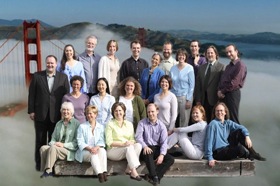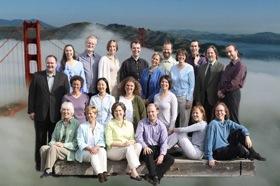
Music Director Magen Solomon revealed the logic, which speaks of the all-a cappella SFCA’s commitment to both the eclectic history and, perhaps, even the more-eclectic future of choral music composition.
“We went to the absolute canon of modern works for choir. It doesn’t get any better than these,” said Solomon. “Everybody who’s ever sung in choir will be familiar with at least some — certainly the Hindemith, or another Poulenc with the same harmonic language.”
Indeed, Holmes called the program “a Golden Oldies concert.” From Charles Ives’ bitonal Psalm 67 (“The men singing in G Minor, the women singing in C Major ...”), composed in the mid-1890s, it marches chronologically through Anton Webern’s Ent flieht auf leichten (composed in 1908, “when he was moving into atonal, but not 12-tonal yet”); Claude Debussy’s Trois Chansons; two of François Poulenc’s Lenten Motets; the pop song A Nightingale Sang in Berkeley Square (1940; Gene Puerling — who died last March — made this Grammy-winning arrangement in 1981 for Manhattan Transfer); Paul Hindemith’s Six Chansons (lyrics by Rilke); Musicians Wrestle Everywhere by Elliot Carter; three of Benjamin Britten’s Five Flower Songs; Ralph Vaughan Williams’ Three Shakespeare Songs of 1951, and so on.
These will be followed by a leap from mid-century to last year’s commissions, with Holmes’ Four e. e. cummings Songs and Marshall’s work The Big Moroccan Sea.
Solomon spoke of what ties the new works to the legacy of the past, and of what advances it: “Good choral music, with strong structure, good melodic and harmonic bones. Both [of SFCA’s resident] composers are very accomplished; their training and what makes their music work goes back to the kind of things that make Debussy work. Both write counterpoint, which is not written much today, when there’s more vertical sonority, not so much on horizontal lines, putting text to melody for voice. They both write very carefully for voice and for the English language. Their music falls very well into voice — and vice versa — not just words smashed together into music.”
Holmes, who teaches physics (as well as the physics of musical instruments) at San José State, plays French horn with several Bay Area symphonies and ensembles. He spoke of the whimsicality of his music, while Solomon stressed its musical seriousness and occasional darkness. Two of the cummings poems, full of charm, treat the theme of mortality.
Marshall, a New Zealander who is composer in residence at Central Florida University and teaches composition there, talked of how a note from a Senegalese, found dead of exposure with 10 others, on a boat that had strayed off course across the Atlantic, provided him with the title and theme for his piece: “I read it, preparing to leave for a new life in the States.” A tenor sings — almost intones — the note, which ends with, “Goodbye. This is the end of my life in this big Moroccan sea.” Marshall concluded, “As the words cease, the music subsides into a wordless evocation of the expanse of sea and sky, or perhaps eternity.”
“Normally, 70 to 80 percent of our concert music is 20th to 21st century,” Solomon stressed. “I’ve premiered 120 new pieces since 1995, many by young, unpublished composers, which have since been published, going into the repertoire. Choral singing is an evanescent art; composition has staying power. It’s like the sound waves that go out into space, after we leave the concert hall.”

